Legislative Assembly of Costa Rica
The Legislative Assembly (Spanish: Asamblea Legislativa) forms the unicameral legislative branch of the Costa Rican government. The national congress building is located in the capital city, San José, specifically in El Carmen District in San José Canton.
Legislative Assembly Asamblea Legislativa de la Republica de Costa Rica | |
|---|---|
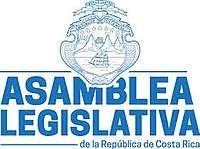 | |
| Type | |
| Type | |
| Leadership | |
President | Eduardo Newton Cruickshank Smith (PRN) |
Vice president | Jorge Luis Fonseca Fonseca (PLN) |
Secretary | María Vita Monge Granados (PUSC) |
| Structure | |
| Seats | 57 |
 | |
Political groups | Government (36)
Opposition (21) |
| Elections | |
| Proportional Representation with seats distributed according to the provinces' population | |
Last election | February 4, 2018 |
Next election | February 6, 2022 |
| Meeting place | |
| San Jose, Costa Rica | |
| Website | |
| http://www.asamblea.go.cr/ | |
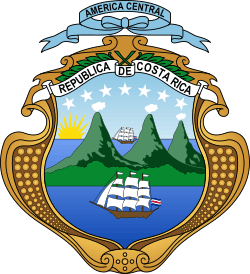 |
|---|
| This article is part of a series on the politics and government of Costa Rica |
|
Legislature
|
|
|
|
|
|
|
The Legislative Assembly is composed of 57 deputies (diputados), who are elected by direct, universal, popular vote on a closed party list proportional representation basis, by province, for four-year terms. A 1949 constitutional amendment prevents deputies from serving for two successive terms, though a deputy may run for an Assembly seat again after sitting out a term. Currently a proposal to switch to a Mixed-member proportional representation based on the German system is under discussion .[1]
| Province | Number of seats | Population |
|---|---|---|
| 19 | 1,404,242 | |
| 11 | 885,571 | |
| 7 | 490,303 | |
| 6 | 433,677 | |
| 5 | 410,929 | |
| 5 | 386,862 | |
| 4 | 354,154 | |
Directorate
Following the 2018 legislative election, the President of the Legislative Assembly was elected in the person of Carolina Herrera Hidalgo, a Citizens' Action Party's member with the support of most of the plenary except for the then unified National Restoration Party's group. The Directory's Secretary went to the National Liberation Party's deputy Luis Fernando Chacon and the Vice Presidency went to Social Christian deputy Inés Solís.
Parties in Legislative Assembly, 2018-2022
Political Parties in, 2018-2022  | ||||||
|---|---|---|---|---|---|---|
| Party Name (English) | Party Name (Spanish) | Abbrev. | Seats | Percentage of Assembly | Party Flag | |
| National Liberation Party | Partido Liberación Nacional | PLN | 17 | 29.82% | ||
| Citizens' Action Party | Partido Acción Ciudadana | PAC | 10 | 17.54% | ||
| Social Christian Unity Party | Partido Unidad Social Cristiana | PUSC | 9 | 15.79% | ||
| National Restoration Party | Partido Restauración Nacional | PREN | 7 | 12.28% | ||
| New Republic Bloc (formerly PREN) | Bloque Nueva República | NR | 6 | 12.28% | ||
| National Integration Party | Partido Integración Nacional | PIN | 2 | 3.51% | ||
| Independent Politician | Diputado Independiente | Ind | 3 | 3.51% | ||
| Social Christian Republican Party | Partido Republicano Social Cristiano | PRSC | 2 | 3.51% | ||
| Broad Front | Frente Amplio | FA | 1 | 1.75% | ||
| 1 | 10 | 17 | 9 | 2 | 2 | 7 | 6 | 3 |
| FA | PAC | PLN | PUSC | PRSC | PIN | PRN | PNR | Ind |
Premises
The Assembly meets in the Edificio Central ("Central Building") located in the city centre of San José. Work began on this building in 1937, with the plan of having it serve as the new presidential palace. Since much of the building materials were imported from Germany and Czechoslovakia, however, the onset of the Second World War put a halt to the project. Work did not recommence until 1957, but by 1958 the legislature was installed and operating in its new premises.
History
The foundations of the Legislative Assembly date back to the establishment of various courts and congresses in New Spain.[2] The modern assembly was created in the aftermath of the Costa Rican Civil War that deposed Teodoro Picado Michalski in 1948. José Figueres Ferrer headed a ruling junta that oversaw the election of a Constituent Assembly. Between 1948 and 1949, this Constituent Assembly created the Constitution of Costa Rica which lays forth the rules governing the assembly today.[3]
During each four-year legislative session, various political parties have occupied majority, minority, and coalition caucuses in the assembly.
Central American Parliament
Costa Rica is the only Spanish-speaking Central American country not to return deputies to the supranational Central American Parliament.
See also
- List of Presidents of the Legislative Assembly of Costa Rica
- Politics of Costa Rica
- List of legislatures by country
References
- Carmona, Fiorella (29 March 2019). "Congreso se acerca al cambio en sistema de elección de diputados". Revista Pulso. Retrieved 28 March 2019.
- Clotilde Obregón Quesada Clotilde (2007). Las Constituciones de Costa Rica. Tomo I. San José, Costa Rica: Editorial de la Universidad de Costa Rica. ISBN 978-9968-936-91-0.
- Dieter Nohlen (2005-04-14). Elections in the Americas A Data Handbook Volume 1: North America, Central America, and the Caribbean. Oxford University Press. ISBN 978-0-19-928357-6.


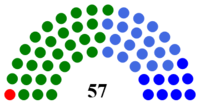

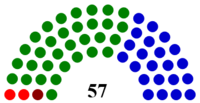
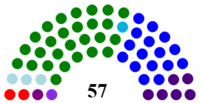
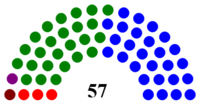

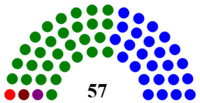
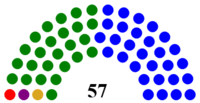
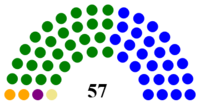

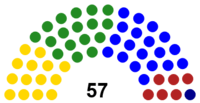



.svg.png)